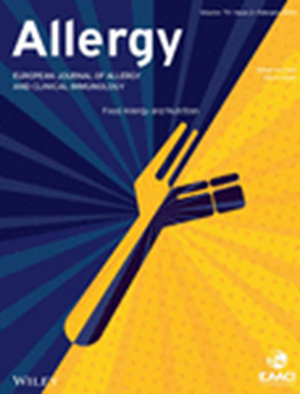桦树花粉和屋尘螨变应性鼻炎患者皮肤点刺自动测试(SPAT)切断值的验证
IF 12.6
1区 医学
Q1 ALLERGY
引用次数: 0
摘要
与传统的皮肤点刺试验(SPT)相比,一种新的设备皮肤点刺自动测试(SPAT)先前显示出更低的可变性和更一致的测试结果,以识别过敏致敏性。本研究旨在临床验证桦树或屋尘螨(HDM)过敏患者调整后的唾液切断。方法纳入75名成人:25名非过敏受试者(经无过敏史和SPT阴性证实),25名桦树和25名HDM变应性鼻炎患者(均经SPT阳性和鼻过敏原挑战[NAC]证实)。所有受试者均接受常规SPT和自动SPT,分别针对B - ver、D - pter、D - far和控制方案。结果用唾液检测桦树过敏和HDM过敏的准确度分别为4.2和4.1 mm。参考先前的研究结果表明4.5 mm是可靠的临界值,我们决定维持4.5 mm作为表明过敏致敏的spv临界值。在检测HDM过敏或桦树花粉过敏方面,SPT(使用4.5 mm时为96%)和传统SPT(使用3.0 mm时为98%)的准确率无显著差异(SPT和SPT均为100%)。通过前臂上的尺子或通过合成图像上的数字测量进行的痰轮测量在分析的任何患者组中都没有显着差异。结论在确认为变应性鼻炎的患者中,与传统SPT相比,使用调整后的4.5 mm SPT切线检测桦树花粉或HDM过敏具有相同的准确性。该网络查看器可以方便有效地用于对合成图像进行数字轮测量。本文章由计算机程序翻译,如有差异,请以英文原文为准。
Validation of the Skin Prick Automated Test (SPAT) Cut‐Off Value in Birch Pollen and House Dust Mite Allergic Rhinitis Patients
IntroductionA novel device, Skin Prick Automated Test (SPAT), previously showed reduced variability and more consistent test results compared to conventional skin prick test (SPT) to identify allergic sensitisation. This study aimed to clinically validate the adjusted SPAT cut‐off in patients with confirmed birch or house dust mite (HDM) allergy.MethodsSeventy‐five adults were included: 25 non‐allergic subjects (confirmed by lack of allergy history and negative SPT), 25 birch and 25 HDM allergic rhinitis patients (both confirmed by positive SPT and nasal allergen challenge [NAC]). All subjects received a conventional SPT and an automated SPT for B ver , D pter , D far and control solutions.ResultsA cut‐off of 4.2 and 4.1 mm, respectively, resulted in the highest accuracy to detect birch or HDM allergy using SPAT. Referring to previous study results suggesting a reliable cut‐off value of 4.5 mm, it was decided to maintain 4.5 mm as SPAT cut‐off indicating allergic sensitisation. Accuracy did not significantly differ between SPAT (96% using 4.5 mm) and conventional SPT (98% using 3.0 mm) to detect HDM allergy or to detect birch pollen allergy (100% for SPAT and SPT). SPAT wheal measurements performed through a ruler on the forearm or through digital measurement on a composite image did not significantly differ for any of the patient groups analysed.ConclusionSPAT showed an equivalent accuracy to detect birch pollen or HDM allergy compared to conventional SPT, using the adjusted 4.5 mm SPAT cut‐off in patients with confirmed allergic rhinitis. The SPAT web viewer can be used easily and effectively for digital wheal measurement on a composite image.
求助全文
通过发布文献求助,成功后即可免费获取论文全文。
去求助
来源期刊

Allergy
医学-过敏
CiteScore
26.10
自引率
9.70%
发文量
393
审稿时长
2 months
期刊介绍:
Allergy is an international and multidisciplinary journal that aims to advance, impact, and communicate all aspects of the discipline of Allergy/Immunology. It publishes original articles, reviews, position papers, guidelines, editorials, news and commentaries, letters to the editors, and correspondences. The journal accepts articles based on their scientific merit and quality.
Allergy seeks to maintain contact between basic and clinical Allergy/Immunology and encourages contributions from contributors and readers from all countries. In addition to its publication, Allergy also provides abstracting and indexing information. Some of the databases that include Allergy abstracts are Abstracts on Hygiene & Communicable Disease, Academic Search Alumni Edition, AgBiotech News & Information, AGRICOLA Database, Biological Abstracts, PubMed Dietary Supplement Subset, and Global Health, among others.
 求助内容:
求助内容: 应助结果提醒方式:
应助结果提醒方式:


